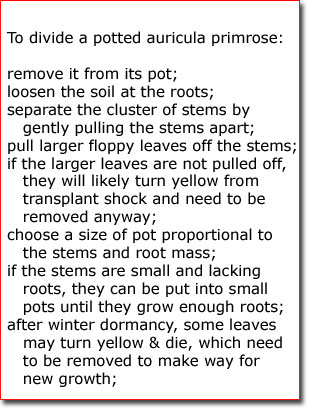Please consider joining the American Primrose Society.
The American Primrose Society is an active group of primrose enthusiasts across North America and beyond, that sends out a quarterly journal to members, and offers a yearly seed exchange among other activities.
The American Primrose Society is an active group of primrose enthusiasts across North America and beyond, that sends out a quarterly journal to members, and offers a yearly seed exchange among other activities.
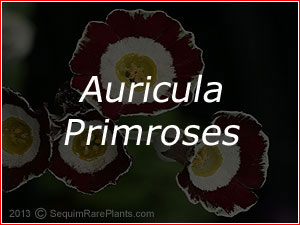
Primula auricula
Auricula primroses have thick, fleshy leaves that are evergreen. They can take severe winter cold, surviving well to −35 to −40°F, with protection such as snow cover. When grown where summers are especially warm, they need a bit of shade during the hottest part of the afternoon.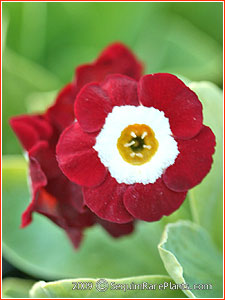
Primula 'American Beauty'
$12.95 Flowers of clear red with white eyes and fleshy green leaves. As with most of the auriculas, the height of the flowering stems is typically about half foot. Cold hardy to −35 to −40°F, with protection such a snow cover..jpg)
Primula 'Anderl'
$12.95 Very dark, velvety red petals that may lighten at their edges.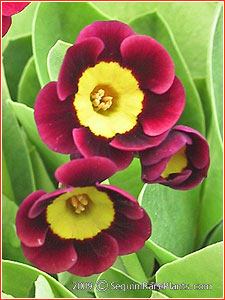
Primula 'Andrea Julie'
$11.95 Richly reddish flowers with lighter edges to her petals. The petals are beautifully rounded. And the center eye of a flower is a rich gold..jpg)
Primula 'Arctic Fox'
$11.95 A double flower in reddish-purple, that was named by Linda Tinnity and Jim Fox. It is vigorous and thrives in Alaska..jpg)
Primula 'Argus'
$11.95 Dark red petals that are a lighter pinkish-red at their edges, 'Argus' is an old primrose that was selected and named in 1897, over one hundred years ago. The eye in the center is a light, cream.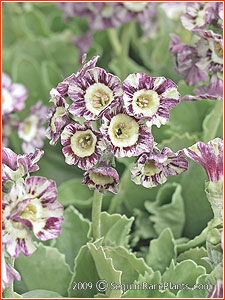
Primula 'Arundel'
$11.95 Arundel has multi-colored, striped flowers of maroon red and creamy green. This is a very vigorous plant..jpg)
Primula 'Astolat'
$13.95 Petals of green and medium-red surround a ring of white that is very pleasing, and fancy..jpg)
Primula 'Barbara Weinz'
$15.95 The petals are large, and a dark blue-purple, encircling a well formed white eye. The plant is compact and vigorous. It was grown by Barbara Weinz of West Bath, Maine, from seed aquired from Herb Dickson..jpg)
Primula 'Bewerly White'
$11.95 The white petals oftentimes have a second row. The base of the petals may have a light touch of yellow to them, as well as the petals having a faint touch of lavender..jpg)
Primula 'Black Star'
$13.95 A single row of petals in a very dark red, bordering on black. We have Cheri Fluck of Sherwood, Oregon to thank for sharing this beauty with us..jpg)
Primula 'Blue Chip'
$12.95 Rather than blue, the petals are a rich royal purple edged in cream..jpg)
Primula 'Brandy'
$12.95 Brandy has double flowers of soft flesh-pink..jpg)
Primula 'Brazil'
$15.95 'Brazil' is colored a rich tawny yellow. It is a vigorous show auricula bred by the British nurseryman, Derek Telford..jpg)
Primula 'Brown Bess'
$15.95 Reddish brown shaded to light beige with a gold center..jpg)
Primula 'Brownie'
$14.95 Double flowers of golden brown are darker before fully opening..jpg)
Primula 'Butter Cream'
$11.95 A very light yellow.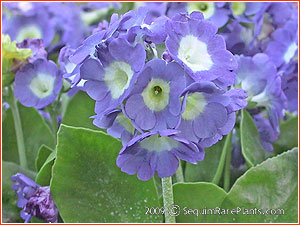
Primula 'Chehalis Blue'
$13.95 'Chehalis Blue' honors the memory of Herb Dickson's nursery that specialized in growing auricula primroses for many years in Chehalis, Washington. A lovely shade of blue with a creamy eye..jpg)
Primula 'Cornmeal'
$15.95 The petals are heavily dusted in powdery meal. They are a grayish green with a blaze of black at their bases, creating a circle of inky blackness surrounding an inner circle of white and a yellowish eye. The white circle ages to a similar color as the eye. Grown by Cyrus Happy. Classified as a gray-edged show auricula.-(225x300).jpg)
Primula 'Dale's Red'
$12.95 A rich red slightly lightening at the edges, and a vigorous grower..jpg)
Primula 'd'Artagnon'
$11.95 Pure white center with very dark, almost black petals. d'Artagnan is one of the central figures in the story of The Three Musketeers..jpg)
Primula 'Della Notte'
$14.95 A ragged edge of dark reddish purple and green with creamy white in the center. (2005-4)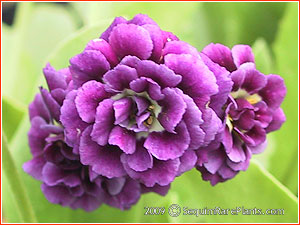
Primula 'Doublet'
$14.95 'Doublet' has double flowers with rich purple petals..jpg)
Primula 'Douglas Black'
$12.95 A “self” of very dark red petals that are near to black..jpg)
Primula 'Emily P.'
$14.95 Double flowers with creamy petals of very light pink and very light yellow..jpg)
Primula 'Eos'
$14.95 Named for, Eos, the goddess of the dawn in Greek mythology, this lovely rose colored, semi double is from Rosetta Jones via Cheri Fluck, who graciously shared it. In some years this plant will produce stamens and pollen, for anyone looking to do some hybridizing..jpg)
Primula 'Fabuloso'
$15.95 Raised by Henry Pugh, the pastel coloring of this flower is amazing. Pale green, yellow and light tan, surrounding a creamy center..jpg)
Primula 'Flaxen Honey'
$15.95 Light tannish brown petals.jpg)
Primula 'Fred Booley'
$11.95 Multi-petalled double flowers of bluish purple. British nurseries describe the color of this flower as French blue. Bred by Derek Salt..jpg)
Primula 'Frou Frou'
$11.95 Ruffled, rose-violoet petals with a light yellow center. (8413).jpg)
Primula 'Gordon Douglas'
$11.95 Deep reddish-purple, lightening at the edges..jpg)
Primula 'Green Shank'
$13.95 Classified as a “fancy” auricula, 'Green Shank' is equally colored in green, rich red and white, with green and red petals and an inner ring of white..jpg)
Primula 'Hawkwood'
$11.95 A fancy auricula, each of its flowers has a thin, fine edge of gray, with maroon-red petals, and a large white eye..jpg)
Primula 'Haysome'
$15.95 This is a show auricula with gray petals and a thin line of black or very dark red at the petals' bases, surrounding a white eye. The leaves have a dusting of farina coloring them in a silvery cast..jpg)
Primula 'Herb's Picotee'
$12.95 Golden yellow with a reddish edge. Selected by Herb Dickson and given to us by Cheri Fluck..jpg)
Primula 'Jeffa'
$13.95 Rich purple petals that lighten at their edges..jpg)
Primula auricula
'Lechistan'
$14.95 Generously given to us by Ian MacGowan, its farina thoroughly and evenly covers the leaves, giving a beautiful background to the richly red flowers.
.jpg)
Primula 'Lemon Chiffon'
$11.95 Creamy light lemon yellow blossoms, named by Herb Dickson..jpg)
Primula 'Lincoln Chestnut'
$14.95 Double flowers of cinnamon-brown, orignially from Derek Salt..jpg)
Primula 'Marie Crousse'
$14.95 Double purplish-mauve flowers..jpg)
Primula 'Marmion'
$12.95 The petals have a green edge and a black base, surrounding a ring of pure white, with the a light yellow inner eye. This beauty grows vigorously..jpg)
Primula 'Misty Blue'
$11.95 This is a cross of Primula 'Olivia' and 'Chehalis Blue' that was given to us by Cheri Fluck. Its blue coloring is lighter than 'Chehalis Blue.'.jpg)
Primula 'Old Mustard'
$12.95 'Old Mustard' has medium tan flowers with white eyes. The clusters of flowers come on especially tall stems to eight inches.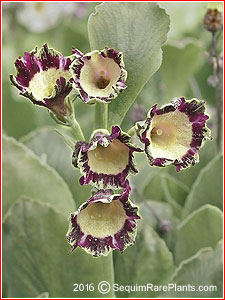
Primula 'Osbourne Green'
$11.95 The shape of this flower is different from most of these primroses. It is long and funnel shaped with a cream center surrounded by an edge of purple tinged green..jpg)
Primula 'Paradise Yellow'
$11.95 Bright yellow flowers forming a rounded cluster..jpg)
Primula 'Parakeet'
$11.95 The colors of 'Parakeet' are a blend of yellow and green, with a chalky white eye..jpg)
Primula 'Pegasus'
$14.95 'Pegasus' has intense, blood-red flowers that are double..jpg)
Primula 'Powder and Paint'
$15.95 Maedythe Martin kindly shared this a few years ago. Lovely red petals, and generously dusted with farina..jpg)
Primula auricula
'Regency Princess'
$11.95 The colors of cream and red contrast wonderfully on these flowers.
.jpg)
Primula 'Remus'
$12.95 A rich, royal purple self with a white eye, and nicely contrasting silvery foliage.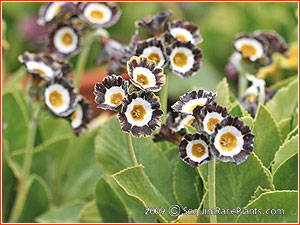
Primula 'RN-25'
$11.95 'RN-25' is similar in coloring to 'Karen Cordrey,' with colors of green, dark red (almost black) and white..jpg)
Primula 'Robin Hood'
$11.95 Here is a palette of fresh spring colors. They are green and yellow, with striping of dark red surrounding a ring of white..jpg)
Primula 'Robinette'
$14.95 Double flowers. The young flower buds are dark at first, and lighten as they open to a rich, ruby-red..jpg)
Primula 'Rosemary'
$13.95 Beautifully rounded petals of rich red flowers. The center of each flower is a pure white..jpg)
Primula 'Sandra'
$12.95 A delight of rose-red that is paler at the edges of the petals, and with a creamy eye at the center..jpg)
Primula 'Sword'
$11.95 An unusual green-edged, double flower on a plant that grows vigorously..jpg)
Primula 'Tasket'
$11.95 Maedythe Martin is hybridizing many lovely auriculas which she shares with the world. Her creation shown here, is a striped flower named, 'Tasket.'.jpg)
Primula 'The Pearl'
$12.95 Semi-double flowers of cream..jpg)
Primula 'Trudeau'
$12.95 This very vigorous plant has very large flowers of rich wine coloring. To emphasize again, it is a strong grower..jpg)
Primula 'Trudy'
$12.95 Her petals are a rich dark red surrounding a clear white eye. Especially attractive are the leaves with their covering of silvery meal.
Primula marginata
'Herb Dickson'
$11.95 Leaves that are gently toothed along the edges, with flowers that are a medium violet.
.jpg)
Primula marginata
'Mauve Mist'
$12.95 Clusters of plum-purple will bloom March into April on stems of 6 to 8 inches. Its attractive, evergreen leaves are deeply notched with soft teeth. For best growth, a site that is partly shaded.
.jpg)
Primula marginata
'White Linda Pope'
$15.95 Toothed margins of the leaves define this species of primrose. Large white flowers bloom in late March to early May. The leaves are succulent and often dusted in a silvery-gray meal. The flowers of 'White Linda Pope' grow to about six inches tall. The leaves are lower, and grow slowly into a widening clump. It is evergreen and decorative in leaf when not blooming.
Un-named Auricula Primroses
Here are several un-named auriculas. They are propagated by division..jpg)
Primula 7810
$10.95 Ragged-edged, striped flowers of reddish purple, green and cream..jpg)
Primula 8195
$10.95 Petals of lavender with a wide creamy center..jpg)
Primula 8202
$10.95 Lavender petals blending into a wide creamy-yellow center..jpg)
Primula 8212
$10.95 Light lavender peatals blending into a creamy center..jpg)
Primula 8415
$10.95 Ruffled flowers with a yellow center, and rich, rose-violet petals..jpg)
Primula 8416
$10.95 Light to medium lavender petals blending into a creamy center, this time with a thrum flower type..png)
A few additional pimroses
.jpg)
Primula x pubescens
'Boothman's Variety'
$11.95 The flowers are 4 - 6 inches tall, a reddish-purle with a white eye, while the foliage reaches only to 4 inches. Blossoms in spring with a repeat in the fall.
.jpg)
Primula 'Charmer'
$11.95 Pendant florets of light purple adorn the stems of 4 to 5 inches in spring. One of Herb Dickson's selections..jpg)
Primula 'Christine Kemp'
$11.95 The light pink flowers bloom just a few inches above the very low foliage..jpg)
Primula 'Darling'
$11.95 The rich maroon-purple flowers reach 6 inches high, while the foliage reaches four inches tall. Another of Herb Dickson's selections..jpg)
Primula 'Dekker'
$11.95 The flowers are pink, 4 inches high, and can completely cover an older plant. Toothed leaves are small and low..jpg)
Different types of primrose flowers
On the left in the picture -- a diagram of a pin-eyed flower, cut from top to bottom (longitudinal cross section), and on the right -- a diagram of a thrum-eyed flower, cut from top to bottom.Insects visit the flowers in search of nectar, which is located at the bottom of the flower tube. This means that only long-tongued insects can actually reach the nectar in the base.
An insect such as a Brimstone butterfly (Gonepteryx rhamni), visiting a pin-eyed flower, gets pollen stuck to the middle of its proboscis from the anthers half-way down the flower tube. If it then goes to visit a thrum-eyed flower, the pollen is perfectly positioned to be wiped off on the stigma, in this case, halfway down the flower tube.
The reverse is also true. If the butterfly first visits a thrum-eyed flower, pollen is wiped off onto the top of its proboscis as it searches for nectar. This is then ideally placed to be transferred onto the stigma of the next pin-eyed flower which it visits. Diagram and information are courtesy of countrysideinfo.co.uk.
Our thoughts on growing Primula pubescens and Primula marginata
Auricula primroses can be a challenge for anyone to grow. One reason is that they don't like hot, humid summer weather, since they're originally from the mountainous regions in Europe where the summer temperatures cool off a lot at night.The soil we use for growing our auricula primroses, is the same soil that we use for all of the other plants that we grow. It's a good quality of potting soil from the company, Sunshine/Sun Gro. The soil that we use is important, however we believe that how the plants are watered is even more important. Although the primroses can be grown either in the ground or in pots, one big advantage to growing them in pots is that you can more easily control how wet or dry their soil is. In our experience, they withstand being too dry better than they do to being kept too wet. If they don't dry out somewhat between waterings, the roots may start to rot.
During a hot summer day, their leaves may wilt, even when their soil is moist. If you think you need to water the plant because you see the wilted leaves, you should check the soil first before watering the plant. If the soil is moist, the leaves are wilting just because of how hot it is and not because the roots are dry. If you water the plant anyhow, and the soil never has a chance to dry out, the roots may start to rot.
Information on growing auriculas often mentions adding grit to their soil to encourage the soil to drain quickly and dry out faster. We don't do that, instead using the same commercial potting soil that we grow all of our other plants in. But we are very careful when we water the primroses. If we're in any doubt about whether a plant should be watered or not, we may wait a day, or as an alternative, just mist the leaves instead of watering the soil.
Another thing that might help is using unglazed, porous, clay pots instead of plastic pots. They can also help to encourage the soil to dry out.
Some auriculas are vigorous growers, and will grow well when planted in the ground in your garden. However, some are less vigorous so it may be best to start with keeping them in pots, and only later on, after you see how they do for you, moving them into the garden. In other words, doing a bit of cautious experimentation.
Dividing an older plant in pictures
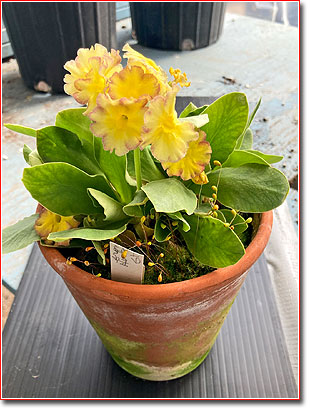
a multi-stemmed plant
This primrose has been in this clay pot for several years, as you can tell by the moss on the soil. It could be left as it is, without dividing, possibly for another two or three years. However, at some point the plant will benefit from being divided and given fresh soil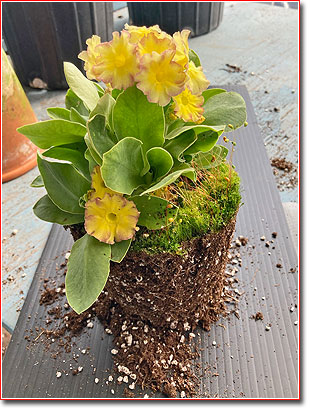
loosen the soil
Here is the same plant as it looks removed from its pot. The roots are crowded but healthy, so it might be left as it is for awhile longer. For the sake of this demonstration, we will divide it. Early spring is the time of year when we divide our primroses.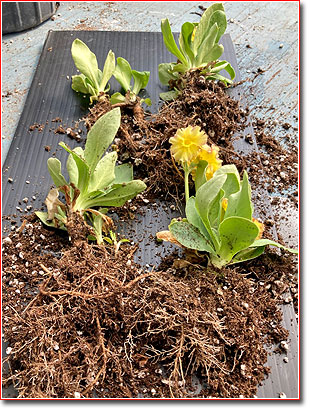
gently separate the stems
Here the plant is divided into stems that have both roots and leaves. The smallest pieces will need special care since they don't have much in the way of roots. It might be better to leave the smallest pieces attached to the larger stems, rather than separating them.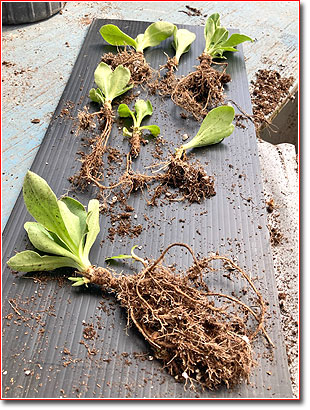
remove the oldest leaves
Here are the same pieces with their lower, older leaves removed, as well as their flowers. Doing this will allow more light and air to reach the center of the newly divided stems, which the plants like. The leaves are removed one at a time, by gently pulling them away from the stems, not by cutting them off.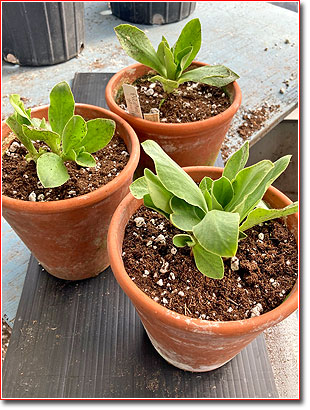
repot into fresh soil
The final step is repotting the divisions into pots with fresh soil. The soil is a good quality commercial potting mix, and not one that is custom-made for the primroses. If the stems are especially long, they can be set lower into the soil because new roots will typically grow from the stems when they are buried.